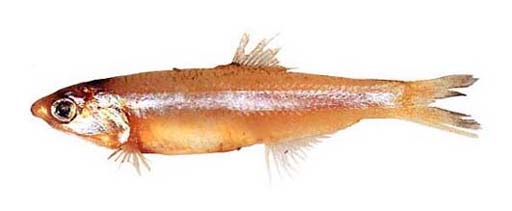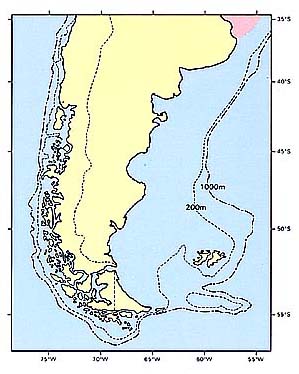カタクチイワシ科
- HOME
- デジタル図鑑
- パタゴニア海域の重要水族
- 硬骨魚綱 ニシン目 カタクチイワシ科
カタクチイワシ科(Engraulidae)

12
ラプラタトガリイワシ(Rapurata-togariiwashi)
Anchoa marini Hildebrand, 1943
特 徴:
背鰭12〜13軟条,臀鰭20〜22軟条,胸鰭14〜16軟条,腹鰭8軟条,鰓耙数17〜20+18-20=37〜38。体長に対する体高の割合は19.6-22.4%,頭長は26.5-28.2%,眼径は6.1〜7.4%,両眼間隔は5.7〜7.1%,吻長は5.8〜6.1%,上顎長は20.5〜21.5%,尾柄高は9.2〜10.5%,胸鰭長は16.6〜17.6%,腹鰭長は8.7〜10.1%,背鰭前長は54.3-56.2%,臀鰭前長は60.9〜64.8%,擬鰓長は5.8〜5.9%。体は紡錘型で中庸に側扁する。腹部に稜鱗はなく,鋭い隆起縁を形成しない。背鰭は体のほぼ中央部にあり,臀鰭起部は背鰭後端の水準よりやや前方に始まる。吻は丸く突出するが,先端は円鈍,眼は大きく,頭長は眼径の3.8〜4.4倍。口は大きく下位で,上顎の後端は尖り,第2上主上顎骨を越え,前鰓蓋骨の縁辺に達する。下顎歯は小さく,数多く密生する。胸鰭の第1鰓条は糸状に延長しない。腹鰭起部は胸鰭起部よりも臀鰭起部により近い。肛門は臀鰭起部の直前にある。擬鰓の長さは眼径より短い。鱗は薄くて大きな円鱗で,脱落しやすい。体の背部は暗青緑色で,中央部に幅の広い銀色の縦帯がある。
分 布:
ブラジルのカボフリオからアルゼンチンのラプラタ河口までの極く沿岸域に分布し,時には汽水,淡水域にも分布すると思われる。
備 考:
通常8〜10cm,最大14cm,成魚は小型プランクトンや底生生物を食べる。アルゼンチンには近縁のA. tricolorが分布するが,臀鰭の位置で異る(Figueiredo and Menezes, 1978)。
(稲田伊史)
Material examined:
5 from Argentina (71.6-97.2 mm SL), FSFL EM 73, 99・1-4.
Description:
D 12-13; A 20-22; P1 14-16; P2 8; GR 17-20+18-20=37-38.
HL 26.5-28.2% of SL; ED 6.1-7.4; BD 19.6-22.4; SN 5.8-6.1; IO 5.7-7.1; UJ 20.5-21.5; CP 9.2-10.5; P1L 16.6-17.6; P2L 8.7-10.1; PreD 54.3-56.2; PreA 60.9-64.8; Pseudobranchiae length 5.8-5.9.
Body fusiform, morderately compressed, belly not sharply keeled, without a series of scutes. Dorsal fin situated near center of body. Anal fin originating just anterior to last dorsal ray. First ray of pectoral fin not filamentous. Pelvic fin base situated nearer to anal fin origin than to pectoral fin base. Snout prominent but bluntly rounded. Eye large, head 3.8 to 4.5 times eye diameter. Mouth large, inferior. Posterior tip of maxilla pointed, projecting beyond 2nd supramaxilla and reaching beyond front border of preopercle. Lower jaw teeth numerous, small and closely set. Anus in front of anal fin. Pseudobranchiae shorter than eye. Scales small, cycloid and deciduous. Dorsal part of body dark blue or greenish, with a wide silver stripe along sides.
Distribution:
From Cabo Frio, Brazil to the mouth of La Plata, Argentina, in shallow coastal waters, sometimes distributed in blackish and fresh waters.
Remarks:
Usually 8-10 cm long, maximum 14 cm SL. Adults feed on small planktonic and benthic organisms. Very closely related species, A. tricolor is also distributed in Argentine waters, but it differs from this species in the position of anal fin (Figueiredo and Menezes, 1978). Three species of Anchoa, A. hepsetus, A. marini and A. tricolor are recognized on Argentine waters so far (Menni, Ringuelet and Aramburu, 1984).
(Tadashi INADA)

Distribution of Anchoa marini in Patagonia.